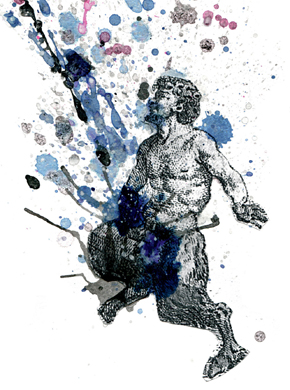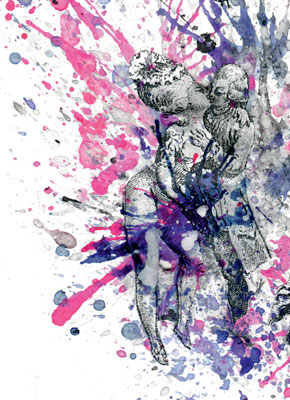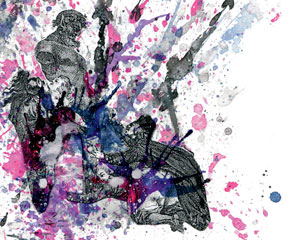 ILLUSTRATIONS: COLLAGE BY BEL FALLEIROS, WITH REPRODUCTIONS FROM THE BOOK THERESE PHILOSOPHE BY THE MARQUIS D´ARGÉNSA libertine is not necessarily, or merely, someone who – as commonly believed – leads a life “focused only on the pleasures of sex,” or someone described as “debauched, dissolute , or libidinous, or, further, a man who does not perform his duties and obligations.”
ILLUSTRATIONS: COLLAGE BY BEL FALLEIROS, WITH REPRODUCTIONS FROM THE BOOK THERESE PHILOSOPHE BY THE MARQUIS D´ARGÉNSA libertine is not necessarily, or merely, someone who – as commonly believed – leads a life “focused only on the pleasures of sex,” or someone described as “debauched, dissolute , or libidinous, or, further, a man who does not perform his duties and obligations.”
The latest definition, as stated in the Dicionário Houaiss dictionary for the word (the references above are from the same source), comes closest to the semantic value mentioned by Luiz Carlos Villalta in his work Livros libertinos e libertinagens em Portugal e no Brasil no ocaso do Antigo Regime [Libertine books and profligacy in Portugal and in Brazil during the sunset of the Ancient Regime]. In the research for his post-doctoral degree, the professor from the Federal University of Minas Gerais (UFMG) states that a libertine can also be someone who, upon exercising the freedom of thought, “ disregards religious rules and dogmas.” In other words, debauchery has a strong political aspect.
In a nineteenth century edition of the Diccionario da Língua Portugueza [Portuguese language dictionary], the word libertine is defined as “one who has shaken the shackles of Revelation and who presumes that only Reason can guide with certainty all that refers to God, future life, &c.fig. that which is licentious in life; in this sense, it is modern.” Thus, the existence of God is analyzed by reason and not by dogma.
Other definitions for the word, adapted according to the historical period, cultural context, or language, recreate the figure of man from the modern era who, driven by the ideas of the Enlightenment, established reason as the essential tool to re-shape a world that until then had been calcified around two powerful elements: the Church and the Monarchy.
 Bel FalleirosThe libertine is the focus of books and documents that provided the basis for the study, supervised by Roger Chartier, from the École des Hautes Études en Sciences Sociales, and by Rogério Fernandes, from the University of Lisbon. In the paper, Villalta re-discusses the licentiousness described in eighteenth century novels, in records on Portuguese censorship at that time, in denouncements to the Inquisition for immoral behavior and heresies, as well as in the rationale of texts written against libertine ideals.
Bel FalleirosThe libertine is the focus of books and documents that provided the basis for the study, supervised by Roger Chartier, from the École des Hautes Études en Sciences Sociales, and by Rogério Fernandes, from the University of Lisbon. In the paper, Villalta re-discusses the licentiousness described in eighteenth century novels, in records on Portuguese censorship at that time, in denouncements to the Inquisition for immoral behavior and heresies, as well as in the rationale of texts written against libertine ideals.
Many of these documents are stored at the Torre do Tombo National Archives, in Lisbon. However, there is also a wealth of books on the subject that are still published today, such as the works of Portugal’s Manuel Maria du Bocage (1765-1805) and France’s Marquis de Sade (1740-1814), who are among the leading authors of the genre.
Villalta has studied the history of books since the 1980s. His doctoral thesis was on censorship, libraries and reading habits in Portugal and Brazil. In his previous studies, he made reference, more than once, to authors referred to as libertines, including a confession attributed to Cláudio Manuel da Costa, a member of the Inconfidência Mineira movement.
Villalta argues that the basis of libertinism resides in the use of reason as the way to understand the world. On account of the primacy of reasoning, the libertine takes on the role of critic par excellence, principally in regard to the “truths” established by the religious authorities, although – and here sexual practices can define a topic within a line of thinking – his principles end up also challenging Christian moral behavior in practice as well.
However, reason rarely lends itself to challenging a single item. According to Villalta, in the second half of the eighteenth century, the word “libertine” gained a new definition among European and Portuguese-Brazilian authors. People who were opposed to Absolute Monarchy were also referred to as libertines. “If we use the primacy of reason, we have the freedom to criticize not only religion but also the political system,” says Villalta.
This does not mean that every libertine dedicated himself to observing the religious and political systems, though some authors pored over one or the other. An example of disassociated themes is found in the work of Jean Baptiste de Boyer, the Marquis d’Argens (1704-1771), a French nobleman who allegedly wrote the novel Therese Philosophe.
Villalta says that the Marquis d’Argens questions religious dogmas while exercising his freedom to create situations – considered immoral by the authorities – in his literature. He describes these situations in great erotic detail, which would cause envy in any current writer of erotic literature. “However, d´Argens was never against Absolute Monarchy,” the researcher points out. Likewise, other writers in those times opposed the political system, yet still made the sign of the cross.
 Bel FalleirosLibidinous behavior partially derives from exercising the freedom preached by the primacy of reason. “Given that libertines think, act, and behave freely, many of them often do not obey the moral rules imposed by religion. In the eyes of the authorities, libertines behaved immorally. This immorality characteristic was often used to tarnish the image of the libertines,” says Villalta.
Bel FalleirosLibidinous behavior partially derives from exercising the freedom preached by the primacy of reason. “Given that libertines think, act, and behave freely, many of them often do not obey the moral rules imposed by religion. In the eyes of the authorities, libertines behaved immorally. This immorality characteristic was often used to tarnish the image of the libertines,” says Villalta.
In the researcher’s opinion, sexual drives render libertines vulnerable to attack by their enemies. “They are individuals who emphasize the prevalence of reason while also giving way to impulse and to passion,” he summarizes, relating these qualities to sexual habits.
Passion
To exemplify the unfolding of this conflict, Villalta refers to Os Maias, by Eça de Queirós (1845-1900), although this novel is based in a later period than the one Villalta has studied. Afonso da Maia wants to raise his son and his grandson in a way that will lead them to submit their passions to the dictates of reason. “He fails with both of them,” Villalta states. “The relationship is strongly focused on in literature and in philosophy. The Marquis d’Argens says that man is not free because he is subject to passion.”
The Marquis de Sade, on the other hand, argued that freedom is the total surrender to passion. Here, this word does not carry the romantic meaning of idealized love. Philosophy in the Bedroom is one of Sade’s best-known novels. The main characters are three libertines who train a young girl in sexual practices that to this day, in the twenty-first century, would embarrass many less liberal people.
Obviously, what is portrayed in literature cannot be interpreted as a report of what actually happened in real life, even though a parallel can be traced. The Marquis d’Argens, for example, felt that everything was allowed in terms of sex, provided that the partner was not harmed, says Villalta. “Sexual intercourse between a man and woman should not result in pregnancy, because pregnancy is shameful; if the woman were a virgin, the man could engage in any kind of sexual act, with the exception of vaginal penetration.”
 Bel FalleirosSinful? According to Christian morality, foreplay was not allowed… In Colonial Brazil, the morality of the faithful established that “simple fornication” – a term used by theologians and by the Inquisition – was not a sin. This leads to the issue of defining what is simple fornication. By exclusion, “simple fornication is fornication that is not complex,” Villalta states ironically. Or, in the language of that time, simple fornication is “fornication that is not qualified.” In other words, it is the genital intercourse between a single man and a women, provided that the woman is not a virgin. Anal intercourse, on the other hand, “qualifies” fornication, which is also the case if one of the partners is married, a member of the clergy, or if the woman is a virgin.
Bel FalleirosSinful? According to Christian morality, foreplay was not allowed… In Colonial Brazil, the morality of the faithful established that “simple fornication” – a term used by theologians and by the Inquisition – was not a sin. This leads to the issue of defining what is simple fornication. By exclusion, “simple fornication is fornication that is not complex,” Villalta states ironically. Or, in the language of that time, simple fornication is “fornication that is not qualified.” In other words, it is the genital intercourse between a single man and a women, provided that the woman is not a virgin. Anal intercourse, on the other hand, “qualifies” fornication, which is also the case if one of the partners is married, a member of the clergy, or if the woman is a virgin.
Homosexuality is a separate issue, that does not come up very often. When it does, it often comes together with some kind of moral burden. In Therese Philosophe, homosexual intercourse is viewed “somewhat negatively,” says Villalta. Many novels mention sexual intercourse between men, especially in convents and monasteries. “In the libertine novels, convents and monasteries are schools of vice and of sin rather than places of virtue. Homosexual intercourse has a lot of room at these places,” the researcher adds.
In Saturnino, porteiro dos cartuxos (the Brazilian version, published in 1842, of a novel allegedly written by Jean-Charles Gervaise de Latouche, first published in France in late 1740 or early 1741), the protagonist, during one of his erotic adventures, identifies, in the convent’s swimming pool, a young girl he desires. The young girl is given to him after he agrees to subject himself to passive sexual intercourse with the priest Casemiro.
Editors
Márcia Abreu, a professor at the Language Studies Institute of the State University of Campinas (Unicamp), states that Saturnino, porteiro dos cartuxos is a direct attack on the behavior of the clergy. The attack is in the form of scenes, instructions, and descriptions of a sexual nature. The book “mobilized, on one hand, book store owners, publishers and readers capable of engaging in extravagant measures to gain access to the book, and, on the other hand, censors, inquisitors and police authorities doing their utmost to prevent the book from circulating.”
The researcher – who also studies libertine novels – adds that many people were persecuted and jailed in Paris as soon as the book started to circulate. Writer and journalist Pascal Pia (1903-1979) described the earliest efforts of the police authorities to identify and detain the book’s author, illustrators, publishers, salespeople and readers. His description was based on the records that remained in the Bastille.
 Bel FalleirosThe documents gathered by Villalta provide the basis for the hypothesis that the literary portrait of homosexuality in the Catholic Church was not merely the result of a fertile imagination. In a monastery in Portugal, Villalta found an accusation from the late eighteenth century, in which a young monk reports that he had been sexually harassed by two other monks. “He denounced them and nobody took action. This is why the young monk was threatened with murder; and this is not fiction,” says Villalta. “Three attempts were made to murder the young monk.”
Bel FalleirosThe documents gathered by Villalta provide the basis for the hypothesis that the literary portrait of homosexuality in the Catholic Church was not merely the result of a fertile imagination. In a monastery in Portugal, Villalta found an accusation from the late eighteenth century, in which a young monk reports that he had been sexually harassed by two other monks. “He denounced them and nobody took action. This is why the young monk was threatened with murder; and this is not fiction,” says Villalta. “Three attempts were made to murder the young monk.”
The researcher adds that other documents from those times describe the close relationship between the clergy and homoerotic practices, described as “the vices of the clergy.” The author emphasizes a significant detail: there are records that two monks, before or after their homoerotic intercourse, and at least once, had read a poem by Bocage called Epístola a Marília. The poem presents religion and the image of hell as elements of moral and political oppression.
Printed documents and manuscripts, used by the censorship authorities, were major sources of references for the researcher. He says that, fortunately, censors read the novels published in those times, discussed them and then determined what could be published and what could not. “These analyses then became official announcements banning the libertine books. Some books were secretly banned, because the censors themselves acknowledged that official announcements could encourage readers to look for the censored books,” says Villalta.
The attempt to fight libertine ideals often produced the opposite effect. Persecuted at the time of the Marquis de Pombal (1699-1782) because he opposed the subordination of the Church to the Portuguese crown, the priest Teodoro de Almeida, in the volumes that comprised his Recreação filosófica, published between 1751 and 1800, ponders on the possible effects of publishing critiques of libertine books. “Such critiques could backfire,” says Villalta. “When you criticize something, you are actually divulging it. In so far as one publishes works that discuss libertine ideas in Portuguese, we make them accessible to an audience that does not read foreign languages.”
The fact is that the Church, in this case, ended up helping matters along. Thanks to the wealth of documents available and to the many books and volumes stored in the drawers of the Inquisition itself, the history of the libertines can finally be re-told.
Republish
